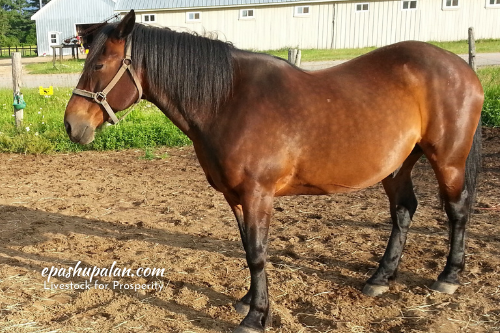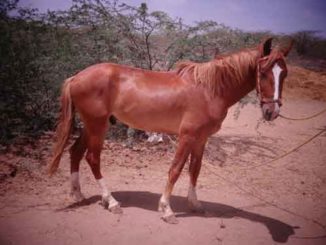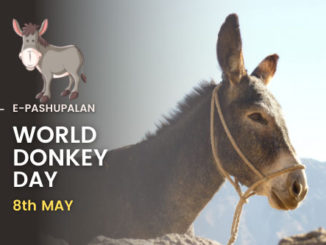Azoturia is a condition in horses that is usually, but not always, associated with exercise and is also known as “Monday morning disease”, “Tying Up” and “Equine Rhabdomyolysis Syndrome”.
Azoturia can develop rapidly and most often occurs when a horse in hard work is given a rest day without having its working diet reduced. It was previously thought that Azoturia occurred due to increased lactic acid levels leading to muscle fatigue and cramps, but more recently it has been concluded that Azoturia is due to a metabolic abnormality in muscle cells resulting in some horses having an underlying susceptibility to the condition which can be triggered by one or more exercise related factors. Mares coming into heat may also be prone to Azoturia.
Causes of Azoturia in Horses
The most common cause of azoturia is over-feeding an active horse during times of rest, such as feeding the same amount of feed to a horse that is being stalled for a day or two instead of cutting rations to accommodate the lack of activity. Too many carbohydrates can cause the muscles to have an acid base imbalance and can cause muscle damage if severe enough.
Over-feeding is not the only cause of azoturia. Since fillies and mares are more at risk, a hormonal imbalance has been suggested as an underlying cause. A thyroid imbalance has also been determined as a cause of azoturia. Researchers have also found a link between azoturia and a deficiency of selenium, vitamin E and calcium.
Symptoms of Azoturia
- As Azoturia develops the muscles of the horse over the loins and quarters harden resulting in cramps and muscular stiffness when exercised. The horse’s stride becomes shorter, it staggers behind and then goes lame and may collapse if work is continued. The horse has a high temperature and sweating may be evident. Examination of the hindquarters will show stiffening. In severe cases the myogolobin released from the damaged muscles turns the urine dark red. Unwilling to walk
- Taking short steps
- Unsteady or stiff on hindquarters
- Muscles feel hard or hot to the touch in the hindquarters
- Cannot move, muscles seized up
- Unable to stand or collapses when trying to move
- Distressed behavior such as excessive head throwing or pawing the ground
- Raised pulse rate
- Reddish-brown or dark chocolate colored urine
- Frequent urination or frequent attempts to urinate
- Slight elevation in body temperature

Diagnosis of Azoturia in Horses
- Complete a full physical examination of horse and may draw blood for a CBC to rule out other possible diseases. A complete medical history of horse, as well as daily routines, will also be helpful when diagnosing azoturia.
- Since azoturia can closely mimic colic, it is important that owner give detailed accounting of all recent activity, type of feed, and amounts of feed given.
- You will also do a muscle biopsy from the muscles just to the side of the tail, the semimembranosus or semitendinosus muscles. The biopsy will determine if there are excessive proteins within the muscles, indicating that horse is suffering from azoturia.
Treatment of azoturia
Once it has been determined that your horse is suffering from azoturia, you will give detailed instructions on caring for your horse to the owner.
The horse should be dismounted and made to rest where it is and veterinary advice should be sought immediately.
Treatment for azoturia may consist of a laxative diet, anti-inflammatories, a sedative, muscle relaxers and massage of the affected muscles. A low energy diet should be fed and the horse may also require a few days rest.
Rest
Keep your horse calm and allow them to rest, preferably in their own stall. Keep the hindquarters warm by putting a coat or blanket over them. Put some hay out for your horse. Eating can calm a horse, just do not give any feed that is carbohydrate based.
Hydration
Encourage re-hydration by offering clean, fresh water often. Keep an eye on how often your horse urinates and if the color is not normal. If you notice extremely dark urine, go for another assessment as there could be an underlying cause that was not diagnosed.
Supplements
In cases of azoturia where nutrient deficiencies are present, you will prescribe a special nutrient rich food for your horse. In some cases, vitamin injections may be necessary.
Care should be taken if there are any changes in horse&its condition, especially if horse refuses to stand or their behavior becomes more and more agitated.
Recovery of Azoturia in Horses
Once a horse has been diagnosed with azoturia, they can become more susceptible to it. Discuss a management plan with owner to minimize the risk of a recurrence.
Most horses make a full recovery when given proper treatment and a lot of TLC. Following treatment plans and being vigilant will help the horse recover without any muscle damage or other permanent damage. There are instances when a veterinarian was not called in time. In these cases, severe muscle damage has occurred and the horse will have to be put down.
Prevention of azoturia
Regular exercise with warming up and cooling down periods together with only the necessary amount of feed and reduction of feed on rest days will help to prevent Azoturia.
| The content of the articles are accurate and true to the best of the author’s knowledge. It is not meant to substitute for diagnosis, prognosis, treatment, prescription, or formal and individualized advice from a veterinary medical professional. Animals exhibiting signs and symptoms of distress should be seen by a veterinarian immediately. |






Be the first to comment